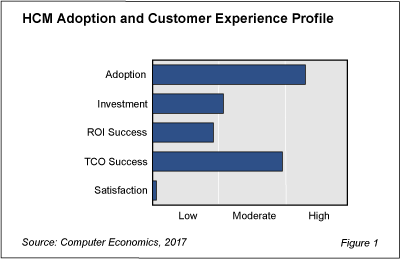Human capital management (HCM) systems are one of the most widely-adopted technologies in business. But despite HCM’s popularity, implementation challenges remain, and the ROI experience and overall satisfaction rating are well below those of other technologies.
Figure 1 from our full report, HCM Adoption Trends and Customer Experience, shows that the adoption rate is high, but the ROI success is low. One potential reason for this is that it is difficult to measure ROI for HCM, as many of the benefits are so-called “soft” benefits that are difficult to measure. These soft benefits—including a better-equipped and more highly skilled workforce, improved employee satisfaction, and reduced risk of regulatory noncompliance—produce a real return but don’t always find their way into any accounting for success.

HCM systems are a collection of applications that serve as the system of record for human resources (employees, contractors, and other personnel) throughout their life cycle, and they support HR-related business processes. Despite the cost challenges, organizations must be realizing value from HCM technology, because the percentage making new investments jumped this year, with the healthcare and public and nonprofit sectors leading the way. Workforce management, reporting structure, payroll, and benefits administration are the most popular functions for new HCM investments this year.
“There is a lot of movement in the HCM market, with many smaller players being acquired in recent years,” said Tom Dunlap, director of research at Computer Economics, an IT research firm based in Irvine, Calif. “However, even though the benefits of HCM systems may seem obvious, there are several challenges in deploying them. Chief among them is that integration with other back-office systems can be difficult. Anyone considering an HCM implementation needs to read our analysis of this fast-changing market.”
The full report quantifies the current adoption and investment trends for HCM technology, as well as the benefits driving companies to expand their HCM implementations. We assess these trends by organization size, sector, and geography and look at the return on investment (ROI) and TCO experiences of organizations that have adopted HCM. We conclude with practical advice for those planning new investments in HCM.
The full report analyzes HCM in comparison to other technologies from our Technology Trends survey. The survey covers the following enterprise systems: ERP, CRM, supply chain management, human capital management, data warehouse/business intelligence, mobile applications, and social business/collaboration systems. We also analyze the following infrastructure technologies: software as a service (SaaS), infrastructure as a service (IaaS), desktop virtualization, software-defined storage, and mobile/wearable devices.
This Research Byte is based on our report on this subject, HCM Adoption Trends and Customer Experience. The full report is available at no charge for Computer Economics clients, or it may be purchased by non-clients directly from our website (click for pricing).

